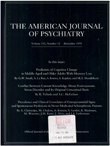Clinical course of alcoholism in 636 male inpatients
Abstract
OBJECTIVE: This study was undertaken to determine the relative order of appearance of symptoms in alcohol dependence. METHOD: The age at which 21 alcohol-related major life events first occurred was investigated in 636 male alcohol-dependent inpatients through a standardized, structured personal interview with each subject and at least one resource person. RESULTS: A general pattern of first occurrence of these events was observed. Heavy drinking escalated further when the subjects were in their late 20s, followed by evidence of interference with functioning in multiple life areas in the early 30s, a subsequent perception of loss of control, and then an intensification of social and job-related problems, along with evidence of deterioration in body systems, in the mid- to late 30s. Similar patterns of problems emerged when the alcoholic subjects were divided into subgroups based on onset of alcohol dependence before or after age 30, presence or absence of a family history of alcoholism, and presence or absence of additional psychiatric disorders. CONCLUSIONS: These data indicate that there is a typical progression of events related to alcohol dependence. This information can be useful for clinicians in their work with patients and for teachers and researchers as well.
Access content
To read the fulltext, please use one of the options below to sign in or purchase access.- Personal login
- Institutional Login
- Sign in via OpenAthens
- Register for access
-
Please login/register if you wish to pair your device and check access availability.
Not a subscriber?
PsychiatryOnline subscription options offer access to the DSM-5 library, books, journals, CME, and patient resources. This all-in-one virtual library provides psychiatrists and mental health professionals with key resources for diagnosis, treatment, research, and professional development.
Need more help? PsychiatryOnline Customer Service may be reached by emailing [email protected] or by calling 800-368-5777 (in the U.S.) or 703-907-7322 (outside the U.S.).



